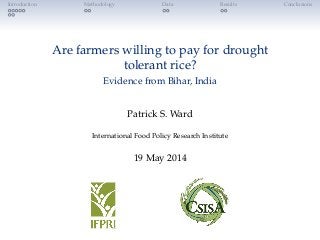
IFPRI- CSISA - Are Farmers Willing to Pay for Drought Tolerant Rice- Patrick Ward
- 1. Introduction Methodology Data Results Conclusions Are farmers willing to pay for drought tolerant rice? Evidence from Bihar, India Patrick S. Ward International Food Policy Research Institute 19 May 2014
- 2. Introduction Methodology Data Results Conclusions Are farmers willing to pay for drought-tolerant rice? Evidence from Bihar, India Aims and objectives Estimate demand for drought-tolerant rice in Bihar using well-structured discrete choice experiments Gain a better understanding for the traits valued by farmers in choosing rice seeds Explore variation in demand and the potential for market segmentation, subsidy targeting, etc. Analyze potential for private/public sector involvement in the delivery of pro-poor technologies
- 3. Introduction Methodology Data Results Conclusions Motivation How do we combine efforts to incentivize private sector innovation with efforts to reach small-scale, resource-poor farmers? Humanitarian use exemptions Ex: Golden Rice for Vitamin A-deficient women and children Technology subsidies Ex: Human and animal vaccines Technology embodiment Ex: open-pollinated varieties of Bt eggplant Market segmentation Ex: Microfinance services
- 4. Introduction Methodology Data Results Conclusions Droughts and rice production in India Droughts present a significant constraint to rice production (Pandey et al., 2007; Serraj et al., 2009) India has 22.3 million ha of unfavorable areas: 6.3 million ha. of upland rice 16 million ha. of rainfed lowland rice 20% of India’s total land area is drought prone Evidence suggests that droughts have been occurring with greater frequency in India since the beginning of the 20th century (World Bank, 2008) When droughts occur, rice production is significantly affected
- 5. Introduction Methodology Data Results Conclusions Droughts and rice production in India
- 6. Introduction Methodology Data Results Conclusions Droughts and area under rice production
- 7. Introduction Methodology Data Results Conclusions Droughts and rice yields
- 8. Introduction Methodology Data Results Conclusions Social consequences of droughts Direct effects are often accompanied by secondary effects: Lower farm incomes Higher food prices for consumers Increased indebtedness Asset depletion Poverty and malnutrition Drought risk reduces productivity even in favorable years because farmers avoid investing in inputs when they fear crop loss (Pandey et al., 2007)
- 9. Introduction Methodology Data Results Conclusions Drought-tolerant rice: Current developments and challenges DT rice may present a means of avoiding the increasing threats of droughts Productivity-enhancing (yield variability reducing) rather than purely productivity-increasing (yield increasing) IRRI Sahbhagi dhan: Released in 2009 in Jharkhand and Odisha Tolerant under drought stress Yield advantage of 29% and 19% over check varieties in rainfed drought-affected conditions Maintains yield advantage even under severe drought No yield penalty under normal conditions Yield advantage of 23% and 31% over check varieties under non-stressed conditions
- 10. Introduction Methodology Data Results Conclusions Challenges to DT adoption Benefits of DT may not be evident at all levels of stress Under normal or irrigated conditions, DT may not perform differently than non-DT At severe stress levels, DT may be indistinguishable from non-DT Moderate drought stress is best for learning about benefits Complicates learning about DT
- 11. Introduction Methodology Data Results Conclusions Methodology Choice experiments are designed to Ascertain how consumers evaluate purchasing options Evaluate demand for goods that consumers may not be familiar with or for which markets do not exist Closely simulate real-world purchasing decisions
- 12. Introduction Methodology Data Results Conclusions Choice tasks
- 13. Introduction Methodology Data Results Conclusions Sample Districts
- 14. Introduction Methodology Data Results Conclusions Rainfall Deficiencies–2012 Kharif
- 15. Introduction Methodology Data Results Conclusions Results: Willingness to pay for rice seed characteristics
- 16. Introduction Methodology Data Results Conclusions Observations Demand for DT hybrid far less sensitive to price than demand for DT inbred Small reduction in price for DT hybrid not likely to have a large effect on DT hybrid demand Significant differences in demand patterns for two seeds Demand for DT hybrid reveals much greater variation Demand for DT inbred does not vary a great deal Potential market segmentation Roles for both public and private sector engagement in discovery, development and delivery of DT seeds
- 17. Introduction Methodology Data Results Conclusions Conclusions Farmers are largely willing to pay a high premium for quality seeds. Farmers in our sample prefer reduction in yield variability offered by DT seeds. They are also willing to pay more for seeds that offered yield advantage even under normal conditions (no yield penalty). A significant segment of the market values the yields and lower seeding rates conferred by hybrid seeds, and the market for inbreds and hybrids can coexist. Results imply a role for both private sector DT hybrids and low-cost DT inbreds through public sector R& D.
- 18. Introduction Methodology Data Results Conclusions Thank you! p.ward@cgiar.org
